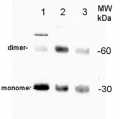Anti-PIP2;1, PIP2;2, PIP2;3 | Plasma membrane intrinistic protein 2-1,2-2,2-3
AS09 491 | Clonality: Polyclonal | Host: Rabbit | Reactivity: A. thaliana, G. coquereliana, R. sativus
Replaced by AS22 4810
- Data sheet
-
- Product Info
-
Immunogen: KLH-conjugated synthetic peptide derived from Arabidopsis thaliana PIP2 proteins: AtPIP2-1, At3g53420 , AtPIP2-2 P43287, At2g37170 , AtPIP2-3 P30302, At2g37180
Host: Rabbit Clonality: Polyclonal Purity: Serum Format: Lyophilized Quantity: 100 µl Reconstitution: For reconstitution add 100 µl of sterile water Storage: Store lyophilized/reconstituted at -20°C; make aliquots to avoid repeated freeze-thaw cycles. Please remember to spin the tubes briefly prior to opening them to avoid any losses that might occur from material adhering to the cap or sides of the tube. Tested applications: ELISA (ELISA), Western blot (WB) Recommended dilution: 1 : 8000 (ELISA), 1 : 1000 (WB) Expected | apparent MW: 30.4 | 28 (PIP2-1,PIP2-2,PIP2-3) kDa - Reactivity
-
Confirmed reactivity: Arabidopsis thaliana, Camelina sativa, Gromphadorhina coquereliana, Raphanus sativus
Predicted reactivity: Brassica napus, Cucumis sativus, Glycine hispida, Gossypium hirsutum, Hedychium coronarium, Mimosa saman, Nicotiana glauca, Petunia hybrida, Pisum sativum, Ricinus communis, Populus tremula x Populus tremloides, Physcomitrium patens
Species of your interest not listed? Contact usNot reactive in: No confirmed exceptions from predicted reactivity are currently known - Application Examples
-
Application example

1 µg and 10 µg of crude membrane fraction/lane from Arabidopsis thaliana were separated on 12 % SDS-PAGE and blotted 1h to PVDF membrane (40 min. at 10 V using BioRad semidry transfer). Filters were blocked 1h with 5 % low-fat milk powder in TBS-T (0.05% Triton X.100). Membranes were washed 5 times with TBS-T, each time in a fresh polystyrene box and probed with anti-PIP2s antibodies (AS09 491, 1:1000, 1h) and secondary anti-rabbit (1:2000, 1 h). All steps were performed in RT with agitation.
- Additional Information
-
Additional information: 0.1% sodium azide is added as preservative. For antibody re-suspending information check the tube lable.
Antibodies will detect target protein in a few µg of a crude preparation loaded per well. If purified preparations of vacuolar and plasma membranes are used, one µg load per well should be sufficient.
Additional information (application): Protein or membrane sample should be treated at 70°C for 10 min before loading on the gel.
Diluted antibody solution can be used 2 to 3 times within one month if it contains 0.1% sodium azide as preservative and is stored at -20ºC to -80ºC.
Triton X-100 should not be included in the protein extraction buffer, when cell organelles or membrane proteins must be separated from soluble proteins. Because, Triton X breaks membrane structure and solubilizes most membranes proteins. Furthermore, it should be noted that Triton X at high concentrations binds SDS and mask the detergent effect of SDS for SDS-PAGE. Also, micelles of Triton X behave as a large complex with molecular mass of 90 kDa at high concentrations in SDS-PAGE.
- Background
-
Background: PIP2;2 is a plasma membrane aquaporin.
Alternative names of isoforms: aquaporin PIP2-1, plasma membrane intrinsic protein 2a, PIP2a, aquaporin PIP2-2, plasma membrane intrinsic protein 2b, PIP2b, TMP2b, Aquaporin PIP2-3, plasma membrane intrinsic protein 2c, PIP2c, TMP2C, RD28-PIP, water stress-induced tonoplast intrinsic protein, (WSII-TIP) - Product Citations
-
Selected references: Carmona-Salazar et al. (2021). Plasma and Vacuolar Membrane Sphingolipidomes: Composition and Insights on The Role of Main Molecular Species. Plant Physiol. 2021 Feb 11:kiab064. doi: 10.1093/plphys/kiab064. Epub ahead of print. PMID: 33570616.
Cano-Ramirez et al. (2021) M. Plasma Membrane Fluidity: An Environment Thermal Detector in Plants. Cells. 2021 Oct 17;10(10):2778. doi: 10.3390/cells10102778. PMID: 34685758; PMCID: PMC8535034.
Hyun-Sung et al. (2019). NaCl-induced CsRCI2E and CsRCI2F interact with aquaporin CsPIP2;1 to reduce water transport in Camelina sativa L. Biochemical and Biophysical Research Communications,Available online 4 April 2019.
Chowanski et al. (2015). Cold induced changes in lipid, protein and carbohydrate levels in the tropical insect Gromphadorhina coquereliana. Comp Biochem Physiol A Mol Integr Physiol. 2015 May;183:57-63. doi: 10.1016/j.cbpa.2015.01.007. Epub 2015 Jan 23.
- Protocols
-
Agrisera Western Blot protocol and video tutorials
Protocols to work with plant and algal protein extracts
Agrisera Educational Posters CollectionMethod for isolation of plant plasma membranes
.jpg)
Courtesy of Dr. Masayoshi Maeshima, Laboratory of Cell Dynamics, Graduate School of Bioagricultural Sciences Nagoya University Nagoya, Japan
- Reviews:
-
This product doesn't have any reviews.


